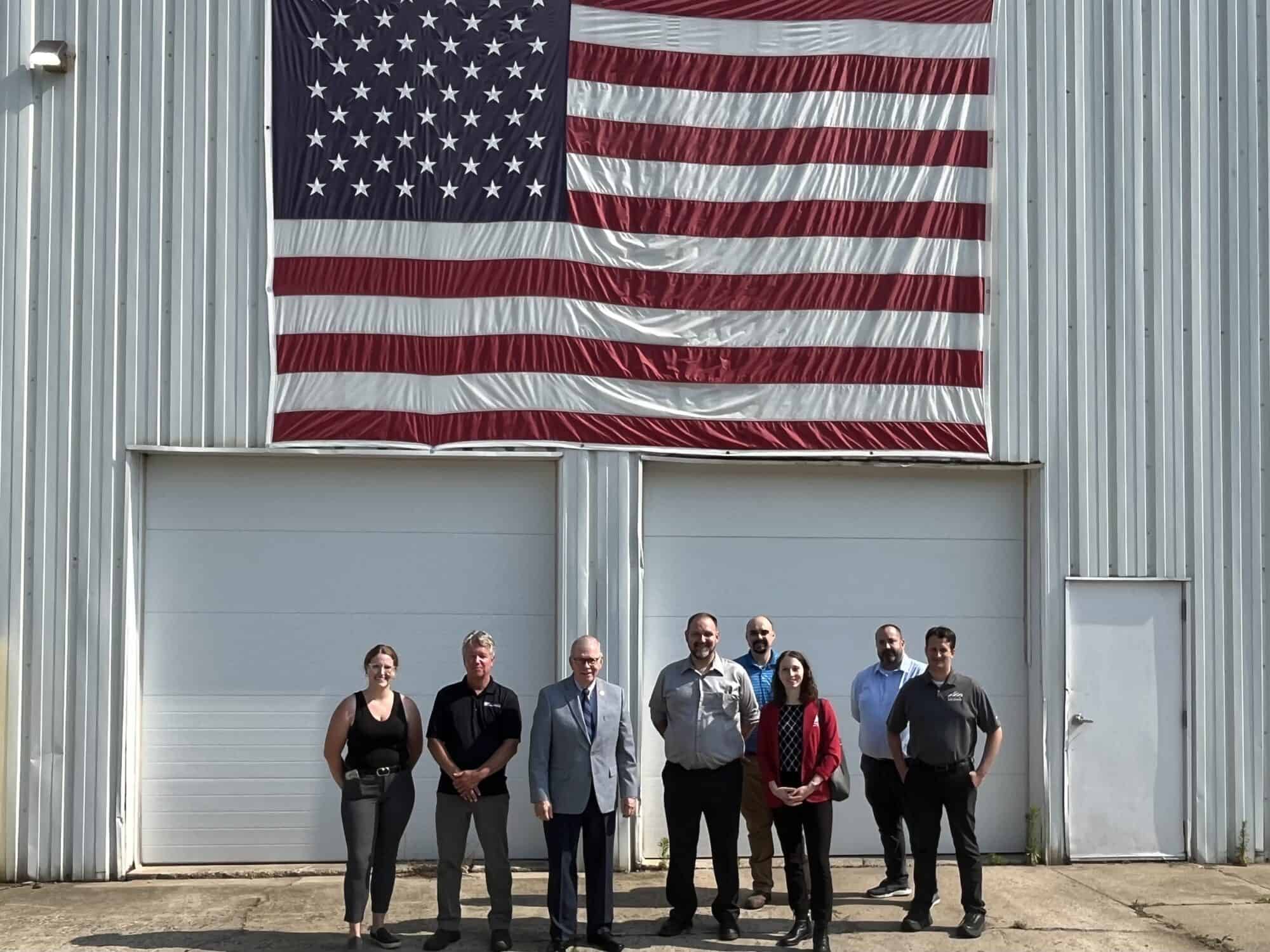Manufacturers to Congress: Stop Devastating Tax Increases
Jobs, innovation, investments in America all at risk if tax provisions expire at the end of 2025
Washington, D.C. – The National Association of Manufacturers released its Manufacturers’ Outlook Survey for the second quarter of 2024, which highlights the immediate need for Congress to take action to prevent tax increases that will limit the industry’s ability to create jobs, support their communities and compete in the global economy.
“When Congress passed tax reform, manufacturers in the U.S. invested in their workers and businesses at a level that had never before been seen. In 2018, we experienced the best year for job creation in 21 years and the best year for wage growth in 15,” said NAM President and CEO Jay Timmons. “Tax reform was rocket fuel for our industry, but our latest Manufacturers’ Outlook Survey illustrates our industry’s deep concerns about the reversal of these pro-growth incentives. If Congress does not take action, job creation, wage growth and investments in communities—in short, America’s manufacturing edge—will be at risk, as well as our country’s ability to attract meaningful investments into our economy. The House, the Senate and the White House need to come together to reinstate the critical provisions that have already expired or begun phasing out, and to stand strong to protect those set to expire at the end of 2025.”
Background:
- The NAM released “What’s At Stake: Manufacturers Face Damaging Tax Increases in 2025,” a policy explainer which illustrates the consequences of allowing the pro-growth policies and rates from the Tax Cuts and Jobs Act to expire.
- The “Manufacturing Wins” issue page on NAM.org provides a hub for 2025 tax content, as well as opportunities for manufacturers to share their stories directly with Congress and the administration.
Key Survey Findings:
- If Congress does not act to prevent tax increases, survey respondents say that increased taxes will limit capital investment opportunities (73.0%), decrease job creation (65.4%), increase difficulty competing globally (52.6%) and reduce R&D spending (51.7%).
- Nearly 94% of respondents agree that Congress should act before the end of 2025 to prevent scheduled tax increases on manufacturers.
- In Q2, 71.9% of respondents felt either somewhat or very positive about their company’s outlook, the seventh straight reading below the moving average (74.8%).
- More than 67% of manufacturers cited the inability to attract and retain employees as their top primary challenge, followed by rising health care costs (66.7%), an unfavorable business climate (59.6%) and a weaker domestic economy (56.8%).
The NAM releases these results to the public each quarter. Further information on the survey is available here.
-NAM-
The National Association of Manufacturers is the largest manufacturing association in the United States, representing small and large manufacturers in every industrial sector and in all 50 states. Manufacturing employs nearly 13 million men and women, contributes $2.89 trillion to the U.S. economy annually and accounts for 53% of private-sector research and development. The NAM is the powerful voice of the manufacturing community and the leading advocate for a policy agenda that helps manufacturers compete in the global economy and create jobs across the United States. For more information about the NAM or to follow us on Twitter and Facebook, please visit www.nam.org.
NYT Investigation: Pharmacy Benefit Managers Drive Up Costs for Employers

Although they were created to keep prescription drug prices down, pharmacy benefit managers “frequently do the opposite” (The New York Times, subscription)—and that’s one of the main reasons the NAM has long advocated for their reform.
What’s going on: “The job of the P.B.M.s is to reduce drug costs. Instead, they …
steer patients toward pricier drugs, charge steep markups on what would otherwise be inexpensive medicines and extract billions of dollars in hidden fees, a New York Times investigation found.”
Why it’s important: PBMs frequently charge employers and government programs, such as Medicare, many times the wholesale cost of a medication and keep the difference, according to the Times.
- And it’s not just those taking prescriptions who pay; when drug costs are inflated, everyone ends up paying higher insurance premiums.
- What’s more, “[b]ecause of recent mergers, [the big three PBMs] are becoming more dominant, collectively processing roughly 80 percent of prescriptions in the United States.” That’s up more than 30% from just 12 years ago.
Working around a workaround: In 2018, in response to growing pressure from employers to get PBMs to share more of the discounts from drug manufacturers, PBMs set up entities known as group purchasing organizations.
- These GPOs pass savings to employers—but they “also began imposing new fees on drug manufacturers,” money they were not contractually bound to pass on to clients.
- The result: “Employers are none the wiser. They receive rebates. But they can’t see the billions of dollars in fees that the G.P.O.s take for themselves.”
Congress makes moves: Since the beginning of last year, seven House and Senate committees have passed PBM-reform legislation, including policies to increase transparency into PBMs’ business practices, delink PBM compensation from medications’ list prices and ensure that rebates are fully passed through to the plan sponsor or patient.
- The NAM has been crucial in educating lawmakers on the need for these reforms and continues to advocate for PBM reform to be signed into law this year.
The last word: “PBMs drive up health care costs for manufacturers and manufacturing workers,” said NAM Vice President of Domestic Policy Charles Crain. “Congress must act as soon as possible to enact comprehensive PBM reform that benefits employers by making PBM contracts more straightforward, transparent and predictable—and benefits workers by reducing the prices they pay out of pocket for their prescriptions.”
Rep. Walberg Visits Madsen Steel Wire Products to Discuss Tax Priorities

Rep. Tim Walberg (R-MI) recently visited Madsen Steel Wire Products in Bronson, Michigan, to discuss critical tax priorities with company leadership and members of the National Association of Manufacturers.
The visit, led by Madsen Steel Wire Products General Manager Steve Cochran, focused on the importance of maintaining a competitive tax code to support growth and innovation in the manufacturing sector in the face of scheduled expirations of key pro-manufacturing tax policies in 2025. The visit also underscored the essential role manufacturing plays in economic growth and stability.
The topline: During the tour, Rep. Walberg witnessed firsthand the impact of pro-growth tax policies on manufacturers.
- “Visiting Madsen Steel Wire Products reinforced the need for tax policy that supports manufacturing growth and job creation,” Walberg said. “We in Congress must act before the end of 2025 to preserve 2017 tax reform and avoid the devastating impacts to small manufacturers that will come to pass if these pro-growth policies are not preserved.”
A close-up view: Cochran shared the company’s experience with 2017 tax reform, highlighting how tax reform enabled significant investments in new equipment and workforce expansion.
- “Tax reform in 2017 was a game-changer for us; it allowed us to invest in our people and technology, driving our competitive edge,” said Cochran. “But the looming expiration of key tax reform provisions creates significant uncertainty for our future planning.”
- “In particular, we face a potential double-whammy as our tax rates are scheduled to increase next year at the same time the pass-through deduction expires—resulting in significant and damaging tax increases for us and other small manufacturers.”
An economic impact: The economic impact of manufacturing on local communities was a central theme of the discussion.
- “Manufacturers like Madsen Steel Wire Products are vital to communities like Bronson,” said Branch County Economic Growth Alliance Director Audrey Tappenden. “Their strength is critical to our local economy and broader industries.”
The big picture: Walberg and Cochran also discussed the broader economic impact of tax reform. The NAM’s recent survey found that 94% of manufacturers believe Congress should act before the end of 2025 to prevent tax increases. The survey also indicated that if tax increases take effect, 73% of manufacturers would limit capital investments and 65% would reduce job creation.
- “Manufacturing is the backbone of our local economy,” said Cochran. “Our ability to invest in new technologies and expand our workforce is dependent on preserving tax reform, which will directly translate to more jobs and better wages for our community.”
The bottom line: “The stakes are high,” said Walberg. “We need to ensure that the tax code continues to support the hardworking men and women in manufacturing. It’s about maintaining a level playing field and ensuring that manufacturers like Madsen Steel Wire Products can thrive—supporting small business growth and the economic health and prosperity of our communities.”
The takeaway: “The NAM launched ‘Manufacturing Wins ’ to preserve tax reform, and Rep. Walberg’s visit to Madsen Steel underscores the critical role of tax policy in driving the success of manufacturers in America,” said NAM Vice President of Domestic Policy Charles Crain. “Congress must act before the end of 2025 to prevent devastating tax increases—bolstering manufacturing across the country and supporting the economic stability and growth of local communities like Bronson, Michigan.”
AI Speeds Drug Development

High-tech drug development labs are training artificial intelligence to design therapeutic treatments more quickly, The New York Times (subscription) reports.
What it looks like: Laboratories are using processes that record huge amounts of data quickly and efficiently—a practice that technology has made possible.
- “[T]he real action is happening at nanoscale: Proteins in solution combine with chemical molecules held in minuscule wells in custom silicon chips that are like microscopic muffin tins. Every interaction is recorded, millions and millions each day, generating 50 terabytes of raw data daily—the equivalent of more than 12,000 movies.”
How it works: By harvesting tremendous amounts of data with mechanized accuracy, these labs can use AI tools to perform rapid experiments, recognize patterns and make predictions about possible solutions—all more quickly than a human practitioner.
- “The companies are leveraging the new technology—which learns from huge amounts of data to generate answers—to try to remake drug discovery. They are moving the field from a painstaking artisanal craft to more automated precision, a shift fueled by AI that learns and gets smarter.”
Why it’s exciting: Traditional drug development processes are typically extremely slow and expensive and frequently end in failure during the human clinical trials stage—often because the drug is not effective enough, or because drugmakers discover unforeseen side effects. With the benefit of AI, biopharmaceutical companies may be able to overcome these challenges.
- “Studies of the cost of designing a drug and navigating clinical trials to final approval vary widely. But the total expense is estimated at $1 billion on average. It takes 10 to 15 years. And nearly 90% of the candidate drugs that enter human clinical trials fail.”
Why it’s safe: The practice is designed to prevent the kind of issues that tend to plague generative AI, and any final medicine still requires significant human input.
- “Because AI for drug development is powered by precise scientific data, toxic ‘hallucinations’ are far less likely than with more broadly trained chatbots. And any potential drug must undergo extensive testing in labs and in clinical trials before it is approved for patients.”
Our take: During a recent event with Axios, titled “Balancing Innovation vs. Regulation,” NAM President and CEO Jay Timmons touched on some of the pioneering work biopharmaceuticals are doing using AI.
- “All of the innovations in the biopharmaceutical industry … are creating new cures for diseases that we’ve been battling for the whole history of mankind,” said Timmons. “We’re accomplishing all of these things now—and it’s so exciting.”
Dig deeper: The NAM’s first-of-its-kind report, “Working Smarter: How Manufacturers Are Using Artificial Intelligence,” details use cases for AI in manufacturing and case studies of how manufacturers are implementing AI technologies. In the report, Johnson & Johnson Executive Vice President and Chief Technical Operations & Risk Officer and NAM Board Chair Kathy Wengel shares how J&J uses AI in clinical trials.
- “When we conduct clinical trials, AI helps us more efficiently establish safety and effectiveness guardrails, while allowing us to conduct trials at a larger scale,” writes Wengel. “AI also gives us a far stronger mastery over our supply chains. Overall, it helps our people do a better job of living up to our commitment of improving health care outcomes and making our towns, country and world a better place.”
Manufacturers Rally to Advance Nuclear Energy

The NAM is pressing the U.S. Senate to support a bill that would promote clean nuclear energy development.
What it does: The legislation, called the Accelerating Deployment of Versatile, Advanced Nuclear for Clean Energy (ADVANCE) Act, offers a number of components to accelerate the development and commercialization of advanced nuclear reactor technologies. It includes:
- Permitting and approval reform to make it easier for reactor projects to locate on brownfield sites, land that is underused or has been abandoned because of industrial waste;
- “Early licensing work” provisions to help deploy reactors more quickly at national security infrastructure sites;
- A series of awards to encourage companies to develop advanced-reactor technology; and
- Hiring support for the Nuclear Regulatory Commission, which is understaffed to deal with the level of applications for new reactors.
Where it stands: The legislation was reported out of the Senate Environment and Public Works Committee with a bipartisan vote of 16–3, and companion legislation was passed in the House of Representatives by an overwhelming vote of 365–36. Now, the NAM is pushing the Senate to pass the bill.
Why it matters: “Nuclear-generated power is an important part of an all-of-the-above energy strategy, which is necessary to meet the power needs of a growing manufacturing sector,” said NAM Managing Vice President of Policy Chris Netram. “The ADVANCE Act would accelerate the development and commercialization of advanced nuclear reactor technologies through reforms to the existing licensing and permitting systems.”
Our action: The NAM is urging Congress to support the bill ahead of the Senate’s vote, detailing its benefits in a letter to senators.
The last word: “Manufacturers create jobs that support families, and develop and deploy innovative technologies that make our environment cleaner,” said Netram. “Increasing our nation’s energy supply, including the growth of nuclear power, will support manufacturing investments and jobs across America.”
Westinghouse Helps Keep Ukraine’s Nuclear Reactors Running

In recent years, an American household company name has been helping keep Ukraine’s nuclear reactors running (The Wall Street Journal, subscription).
What’s going on: After Russia’s invasion in 2022, Ukraine stopped buying nuclear fuel from Moscow, formerly its top supplier. That’s when Westinghouse Electric stepped in.
- The Pennsylvania-headquartered company “now makes fuel bundles that are compatible with all of the country’s [Soviet-designed VVER] reactors and is working on a plan that could allow Ukraine to start making some of that fuel itself. Ukraine also plans to build nine Westinghouse-designed reactors.”
Why it’s important: The change is a victory for the West, “which has long sought to erode Russia’s dominance in the industry and the political influence that comes with it.”
- Russia has about 44% of the world’s uranium-enrichment capacity, which is critical because nuclear reactors use uranium for power production.
A decade in the making: After Russia seized Crimea in 2014, Ukrainian state nuclear company “Energoatom ramped up purchases of Westinghouse’s fuel assemblies and, by the beginning of 2022, six of Ukraine’s 15 reactors had been loaded with fuel from the company.”
- The firm also began supplying Ukraine with fuel assemblies for the VVER-440 reactor, of which the country has two.
A critical moment: As part of its full-scale invasion of Ukraine two years ago, Russia occupied the country’s largest nuclear power station, Zaporizhzhia, and attacked other energy infrastructure.
- Energoatom had to move fast to maintain deliveries of Westinghouse’s VVER-440 fuel, without which one of Ukraine’s nuclear reactors might need to be shuttered, worsening an electricity shortage.
- “What followed was a high-stakes race to make the fuel and load it in a reactor near the western Ukrainian city of Rivne, which faced occasional aerial bombardment despite being far from the war’s front line.”
- Westinghouse raced to source new machinery and rework its factory floor in Sweden, “upending traditional ways of working in a tightly regulated sector that is better known for its glacial pace.”
How it succeeded: The company set up a 60-person task force to meet and identify potential bottlenecks in production and launched talks with other European utilities.
- It got the Czech Republic and other countries with VVER-440 reactors “to accept the same basic fuel assembly design as the one Westinghouse was planning to use for Ukraine—a step officials said helped speed up production because it eliminated some of the time the company would usually spend on customization.”
- Utilities in five countries, including Ukraine, have since signed deals with Westinghouse for fuel deliveries.
- Experts from Energoatom went back and forth between Ukraine and Sweden to help with the fuel development, and in September, the new fuel assemblies were ready.
A nuclear future: To produce the fuel, Westinghouse purchased new manufacturing equipment, repurposed older equipment and 3-D printed some detailed components.
- “Westinghouse delivered a first batch of VVER fuel to a nuclear power plant in Bulgaria this spring and has said a delivery to the Czech Republic should take place this year.”
NAM, Partners Urge Administration to Withdraw “March-in” Proposal

If finalized, guidance proposed last year by the Biden administration to allow the federal government to seize manufacturers’ intellectual property rights would be ruinous to the U.S. innovation economy, the NAM and state partners told Commerce Secretary Gina Raimondo this week.
What’s going on: In December, the Biden administration issued a proposal to enable government agencies to “march in” and revoke companies’ patent exclusivity if a product’s development was funded in any part by federal research dollars.
- Under the proposal, the government’s decision of whether to march in would be based on a product’s price—effectively imposing government-mandated price controls on innovative products like clean energy solutions, next-generation semiconductors and lifesaving medicines.
Manufacturers fight back: The NAM and a coalition of regional and state manufacturing associations are pushing back, highlighting the importance of ironclad IP rights to groundbreaking innovation.
- “[T]urning groundbreaking R&D into innovative products for the American people is only possible if creators—from university researchers to early-stage entrepreneurs to established businesses—can rely on strong intellectual property protections,” the associations told Raimondo.
Small business impacts: Startups and small businesses would pay the heaviest toll if the new march-in standards are finalized.
- Scientists and researchers at universities nationwide will face difficulties in partnering with the industry and in founding startups based on their research, “strik[ing] a blow to the local economies in [all 50] states that depend on university-centered innovation hubs for job creation and economic growth.”
- If a promising idea makes it out of the lab, outside investors will be reluctant to inject the capital necessary for further R&D and product development—resulting in fewer life-changing and lifesaving products for the American people.
What needs to happen: Manufacturers are calling on the Biden administration to reverse course.
- “We urge you to protect our local, state and regional economies, which benefit from breakthrough research, entrepreneurship and modern manufacturing, by withdrawing the proposed march-in guidance.”
Manufacturers Launch “Manufacturing Wins” Campaign to Prevent Devastating Tax Increases in 2025
Washington, D.C. – The National Association of Manufacturers has launched an industry-wide effort to educate Congress and the administration on the need for urgent action to preserve the pro-growth 2017 tax reform provisions set to expire at the end of 2025.
NAM President and CEO Jay Timmons, Ketchie President and Owner and NAM Small and Medium Manufacturers Group Chair Courtney Silver and Husco President and CEO and NAM Executive Committee member Austin Ramirez released the following statements:
“The transformative impact of 2017 tax reform cannot be overstated. Tax reform was rocket fuel, igniting a resurgence in the manufacturing sector. It put into place competitive policies that fueled record job creation, wage growth, capital investment and innovation,” said Timmons. “However, if Congress does not act, next year’s expiration of these powerful force multipliers will undo much of the progress made by our industry and America. Manufacturers are putting a stake in the ground and warning policymakers to stand up against any tax increases on the people who make things in America.”
“If Congress does not act before the end of 2025, manufacturers will be competing with one hand tied behind our back. Manufacturers across the country promised to take tax reform’s pro-growth provisions and ensure they had a direct positive impact on American lives,” said Silver. “We kept our promises. We created jobs, we purchased equipment and we gave back to our communities. I urge Congress to build on the promise of tax reform to enable manufacturers to do even more.”
“The stakes are high—the economic damage will be severe if Congress decides that it’s time to end tax reform,” said Ramirez. “Allowing tax reform to sunset means tax hikes on manufacturers and manufacturing families, which will slow our sector’s growth and prevent us from investing in job-creating projects that support communities across the country and boost our economy.”
Background:
Critical tax reform provisions are set to expire at the end of 2025, resulting in significant tax increases for virtually all manufacturers.
- A recent NAM survey found that 94% of manufacturers believe Congress should act before the end of 2025 to prevent these tax increases.
- If Congress fails to act, 73% of manufacturers would be forced to limit capital investments, 65% would have to reduce job creation and 52% would spend less on R&D, among other damaging impacts.
- Additionally, 93% of pass-through manufacturers said that the loss of the pass-through deduction, which ensures a level-playing field for small businesses that pay tax at individual tax rates, would harm their ability to grow, create jobs and invest in their business.
- Released by the NAM today, What’s at Stake: Manufacturers Face Devastating Tax Increases in 2025, explores the pro-growth policies from the Tax Cuts and Jobs Act and explains why allowing them to expire would damage the manufacturing economy.
- The “Manufacturing Wins” issue page on NAM.org provides a hub for 2025 tax content as well as opportunities for manufacturers to share their stories directly with Congress and the administration.
- The NAM submitted a letter today to House Ways and Means Committee Chairman Jason Smith (R-MO) and Ranking Member Richard Neal (D-MA) and Senate Finance Committee Chairman Ron Wyden (D-OR) and Ranking Member Mike Crapo (R-ID) outlining manufacturers’ tax priorities for 2025.
-NAM-
The National Association of Manufacturers is the largest manufacturing association in the United States, representing small and large manufacturers in every industrial sector and in all 50 states. Manufacturing employs nearly 13 million men and women, contributes $2.89 trillion to the U.S. economy annually and accounts for 53% of private-sector research and development. The NAM is the powerful voice of the manufacturing community and the leading advocate for a policy agenda that helps manufacturers compete in the global economy and create jobs across the United States. For more information about the NAM or to follow us on Twitter and Facebook, please visit www.nam.org.
10th Anniversary of NAM President and CEO’s “Four Pillars” Speech

NAM President and CEO Jay Timmons delivered a defining speech at the Friends of Adam Smith Awards a decade ago. This speech outlined the “Four Pillars of an Exceptional America,” a framework that continues to shape the NAM’s mission and advocacy.
Flashback: On June 11, 2014, in his speech accepting the 2014 Business Citizen Award for an outstanding record of achievement in advancing the principles of free enterprise, Timmons introduced the four pillars that underpin American exceptionalism and manufacturing strength.
The Four Pillars:
- Free enterprise: The economic system that unleashes innovation, creates opportunity and lifts humankind out of poverty more than any other economic system has in the history of the world.
- Competitiveness: Our ability, when untethered from government overreach, to prosper and win in a global economy.
- Individual liberty: The unique freedoms enshrined in our Constitution and Bill of Rights that enable us to live and succeed.
- Equal opportunity: Our shared belief that we all have the ability to contribute to the betterment of our families, our companies, our communities and our country.
Manufacturers’ approval: The NAM Board of Directors unanimously adopted these pillars as part of the association’s official policy positions, guiding the NAM’s Competing to Win agenda to bolster the competitiveness of manufacturers in the United States.
The impact: These pillars have guided the NAM’s efforts in promoting policies that support a robust manufacturing industry and a strong national economy, helping to draw support across the political divide for manufacturers’ principles-based agenda.
The bottom line: “The Four Pillars are not just about manufacturing; they are about sustaining the promise of America,” said NAM Executive Vice President Erin Streeter. “That’s why these values have helped us ensure the manufacturing agenda is a post-partisan agenda, drawing support for so many of our priorities from policymakers and by candidates—on both sides of the aisle—on the campaign trail. We will continue to work with anyone who wants to advance these values.”
NAM, ACC Challenge EPA’s National Drinking Water Rule

The NAM and the American Chemistry Council yesterday filed a petition challenging the Environmental Protection Agency’s first-ever national drinking water standard limiting the presence of six types of per- and polyfluoroalkyl substances, or PFAS.
What’s going on: The organizations are seeking to overturn the final rule—issued in April by the EPA—in the D.C. Circuit Court of Appeals on the grounds that it exceeds the agency’s authority under the Safe Drinking Water Act of 1974 and “is arbitrary, capricious and an abuse of discretion,” in violation of the Administrative Procedure Act.
- Under the rule, PFAS in municipal water systems are limited to near-zero levels. Systems nationwide will have three years to monitor for the chemicals and two subsequent years to install technology to reduce the compounds’ levels in the water.
- The water systems will (and, in fact, have already begun to) sue manufacturers to cover their costs. Meanwhile, plaintiffs’ attorneys are using the standard in product liability and greenwashing suits against manufacturers.
- PFAS are a diverse group of chemicals that have been used widely for decades due to their unique ability to douse fires and resist grease, stains and corrosion. Today they’re a key component in a wide range of critical products, from semiconductors, to the components of the electrical grid, to renewable-energy production equipment.
Why it’s problematic: The final regulation of PFAS “is wholly infeasible and threatens these vital substances’ continued application in manufacturing processes,” said NAM Chief Legal Officer Linda Kelly, adding that the agency’s rulemaking is based “on a deeply flawed cost-benefit analysis” and fails to follow Safe Drinking Water Act procedure and other statutory requirements.
- “In many instances, there is no viable alternative for these chemicals, and companies may be forced to change plans dramatically” to follow the new rule, NAM Managing Vice President of Policy Chris Netram said in April.
- “In everyday life, including emergency situations like a fire or operating room circumstance, there’s a real reliance on these products—it’s not just about job losses and costs but fundamental decisions that have widespread ramifications,” Netram added recently.
What should be done: The rule should be vacated as soon as possible, the NAM and the ACC told the court.
